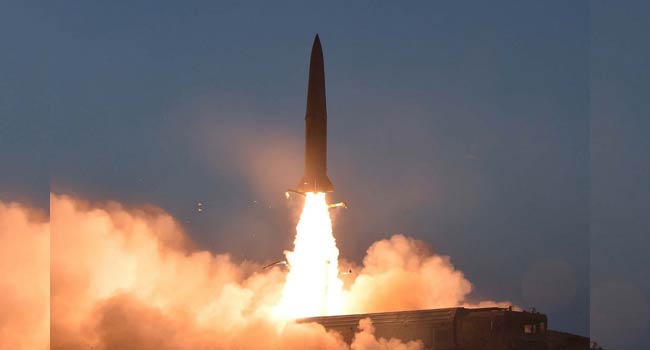
North Korea fired two short-range missiles into the sea on Thursday, complicating efforts to resume stalled nuclear talks with Washington and signalling its anger over planned US-South Korea joint military exercises.
It was Pyongyang’s first missile test since an impromptu meeting between US President Donald Trump and North Korean leader Kim Jong Un last month that produced an agreement to resume a working-level denuclearisation dialogue.
But those talks have yet to begin and North Korea warned recently they could be derailed by Washington and Seoul’s refusal to scrap military exercises scheduled for next month.
South Korea’s Joint Chiefs of Staff (JCS) said the two missiles were launched just after dawn from Wonsan on the east coast.
Earlier in the day, a JCS official in Seoul said one of the two weapons flew more than 430 kilometres (270 miles), while the other travelled 690 kilometres and appeared to be a “new type of missile”.
But in the evening Seoul’s National Security Office (NSC) of the presidential Blue House said both of the two missiles are “analysed” to be “new type of short-range ballistic missiles”.
“We urge the North to stop actions that do not help ease military tensions,” said Choi Hyun-soo, a defence ministry spokeswoman for South Korea, while the NSC said it expressed “strong concern”.
Washington called for an end to unspecified “provocations.”
“We want to have diplomatic engagement with NorthKorea, and we continue to urge the North Koreans to resolve all the things that the president and Chairman Kim have talked about through diplomacy,” said US State Department spokeswoman Morgan Ortagus.
“We urge no more provocations, and that all parties should abide by their obligations under (United Nations Security Council) resolutions,” Ortagus said.
Ortagus, however, refused to say if she considered the missile tests “provocations.”
Japan’s defence minister called the launches “extremely regrettable” but stressed that the missiles had fallen short of his country’s exclusive economic zone.
Pyongyang carried out similar short-range launches in May, which Trump dismissed at the time as “very standard stuff” that would have no impact on his relationship with Kim.
The two leaders went on to hold an unscheduled meeting June 30 in the Demilitarized Zone that divides the two Koreas, where they agreed to pick up a nuclear dialogue that stalled after the collapse of the second Trump-Kim summit in February.
US Secretary of State Mike Pompeo said the working-level disarmament talks would probably start in mid-July, but last week Pyongyang said they had been jeopardised by the scheduled joint military drills.
Condemning the exercises as “blatant pressure”, Pyongyang even hinted it could reconsider its moratorium on nuclear and long-range missile testing.
‘Strong message’
Thursday’s launches came a day after Trump’s National Security Advisor John Bolton — an arch-hawk regularly vilified by North Korean state media — held talks with senior South Korean officials in Seoul.
The latest missile tests were a “strong message” that should be seen as “part of Pyongyang’s protest” against the military drills, said Cheong Seong-chang, an analyst at the Sejong Institute.
There are close to 30,000 US troops stationed in South Korea, and their annual manoeuvres with South Korean soldiers have always infuriated Pyongyang.
Other analysts said opposition to the drills was merely a pretext for Pyongyang to pursue its weapons ambitions.
“I think today’s launches are part of a larger plan for North Korea’s advanced missile programme, rather than its protest against the upcoming military drill,” said Hong Min, a senior researcher at the South’s state-run Korea Institute for National Unification.
North Korean state media published pictures this week of Kim inspecting a new submarine, fuelling concerns that Pyongyang was pushing ahead with a submarine-launched ballistic missile (SLBM) programme.
“The current bargain is: don’t test nuclear warheads or long range missiles and the United States won’t object or seriously try to stop it,” tweeted Adam Mount of the Federation of American Scientists.
Vague words
At their first summit in Singapore in June 2018, Trump and Kim adopted a vaguely worded statement on “complete denuclearisation of the Korean peninsula”.
But the failure to reach an agreement over relief from US sanctions, and what the North was willing to give in return, led to the collapse of their next summit in Hanoi.
Trump insists that his personal relationship with Kim is strong enough to keep a dialogue with North Korea on track despite provocations like short-range missile launches.
Asked on Tuesday whether any meetings were scheduled, Trump said: “No, we just have a very good relationship. And probably they would like to meet and we’ll see what happens.”
“There was a little correspondence recently, very positive correspondence with North Korea.”
He said there had been “no nuclear testing, there’s no missile testing, there’s no nothing.”
AFP

